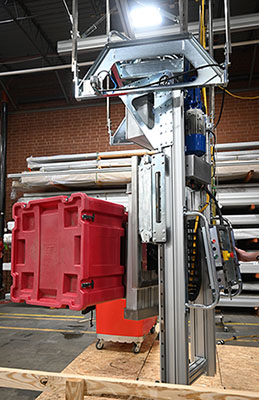
Bridge Crane Container Handling
February 28, 2023
PROMAT Trade Show, Recap, 2023
April 6, 2023In the world of material handling, the importance of ergonomic lifting cannot be overstated. Ergonomic lifting refers to the safe and efficient lifting of heavy objects or loads, using techniques and equipment that minimize the risk of injury to the worker. In this blog, we will discuss the importance of ergonomic lifting and how it can help workers stay safe and productive on the job.
First and foremost, ergonomic lifting techniques are essential for preventing workplace injuries. According to the Occupational Safety and Health Administration (OSHA), overexertion and musculoskeletal disorders caused by improper lifting are some of the leading causes of workplace injuries. These injuries can result in lost workdays, reduced productivity, and even long-term disability. By using ergonomic lifting techniques, workers can reduce the risk of injury and stay healthy on the job.
In addition to preventing injuries, ergonomic lifting can also increase productivity and efficiency in the workplace. When workers use proper lifting techniques, they can move heavy objects more easily and quickly, reducing the time it takes to complete tasks. This can lead to increased output and profitability for businesses.
Ergonomic lifting techniques can also help reduce worker fatigue and improve morale. When workers are trained in safe lifting practices and have access to ergonomic lifting equipment, they are less likely to experience physical strain and fatigue. This can lead to improved job satisfaction and reduced turnover rates.
So, what are some examples of ergonomic lifting techniques and equipment? Here are a few:
- Proper lifting technique:
- Workers should use a “lift with your legs, not your back” approach when lifting heavy objects. This means bending at the knees and hips, rather than the waist, and using leg muscles to lift the load.
- Personal protective equipment:
- Workers should wear appropriate personal protective equipment, such as back braces and safety shoes, to reduce the risk of injury.
- Job rotation and rest breaks:
- Employers can also implement job rotation and rest breaks to reduce the risk of overexertion and fatigue.
- Lifting aids:
- There are many lifting aids available to help workers move heavy objects more safely and efficiently. These include a variety of equipment you can find at www.RonI.com, as well as, www.VacuhandProCrane.com.
Industries That Require Ergonomic Lifting:
- Automotive
- Chemical
- Logistics
- Food and Beverage
- Pharmacy
- Wood and Steel
Applications That Require Ergonomic Lifting:
What’s Going On At RonI…
Recent Blog Posts:
Upcoming + Future Tradeshow Events
Interested In Leaving A Comment?
We would love to hear your thoughts regarding this blog. Scroll down below and tell us what you think!

